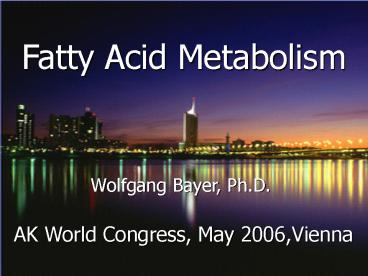Folie 1 - PowerPoint PPT Presentation
1 / 20
Title:
Folie 1
Description:
oleic acid. linoleic acid, a-linolenic acid, docosahexaenoic acid, H3C CH3 H3C H. C C C C ... oleic acid. 18:1, ?-9. linoleic acid. 18:2, ?-6. a-linolenic acid ... – PowerPoint PPT presentation
Number of Views:58
Avg rating:3.0/5.0
Title: Folie 1
1
Fatty Acid Metabolism
Wolfgang Bayer, Ph.D.
AK World Congress, May 2006,Vienna
2
Fat what is it?
H2-C-OH HOOC-(CH2)14-CH3 H-C-OH
HOOC-(CH2)14-CH3 H2-C-OH
HOOC-(CH2)14-CH3 glycerol palmitic acid
H2-C-OOC-(CH2)14-CH3 H-C-OOC-(CH2)14-CH3 H2-C-OOC
-(CH2)14-CH3 triglycerid
- 3 H2O
Natural fats and oils are comprised of glycerol
esters of the higher even-numbered fatty acids
triglycerides
3
fatty acid 1
fatty acid 1
glycerol
glycerol
fatty acid 2
fatty acid 2
fatty acid 3
phosphate
choline
P
P
triglycerid
phospholipid (phosphatidylcholin)
fatty acid
fatty acid
sphingosine
sphingosine
sugar
choline
P
sphingolipid (sphingomyelin)
glycolipid (cerebrosid)
4
fatty acids
saturated fatty acids
unsaturated fatty acids
monounsaturated fatty acids
polyunsaturated fatty acids
?-3 fatty acids
?-6 fatty acids
5
Fatty acids - nomenclature
What is the designation for this fatty acid?
d-end
?-end
1
18
9
12
15
cis-9,12,15-octadecatrienoic acid
183, ?-3
a-linolenic acid
6
stearic acid, 180
saturated mono- unsaturated poly- unsaturated
oleic acid
linoleic acid,
a-
a-linolenic acid,
docosahexaenoic acid,
7
Cis and trans fatty acids
trans
cis
H3C CH3 H3C
H C C
C C H
H H
CH3
Cis fatty acids are the naturally occurring forms
of fatty acids. Trans fatty acids are produced
when fats are hydrogenated (margarine). They have
rigid structures and are described as having
atherogenic properties.
8
Uptake and synthesis of fatty acids (1)
In the duodenum, nutritional fats (triglycerides)
are split by lipases into monoglycerides and free
fatty acids. Following absorption, triglycerides
are resynthesized, then transported to tissues,
or stored in fatty tissues, by means of
chylomicrons.
Fatty acids can be synthesized endogenously from
glucose by means of the enzyme fatty acid
synthase (FAS). This process results in saturated
fatty acids with up to 16 C atoms palmitic acid
(C 160).
9
Uptake and synthesis of fatty acids (2)
Following reactions result in extended saturated
and monounsaturated fatty acids, but not in the
poly-unsaturated C 18 fatty acids (?-3 and ?-6).
Triglycerides can be synthesized from the fatty
acids produced in the liver. They enter the
bloodstream bound to VLDLs. Fats are stored in
fat cells (adipocytes), where they are
continuously built up and broken down. The amount
of body fat is approx. 8-15 kg in men and 10-20
kg in women.
10
Fatty acid breakdown by ß-oxidation The fatty
acid is short-ened by 2 C atoms in each reaction
cycle. Acetyl-CoA is prod-uced, which can then be
metabolized to CO2 and ATP in the citrate
cycle. 1 mol of palmitic acid produces 106 mols
of ATP, equiv-alent to 3,300 kJ/mol.
coenzyme A
11
Fatty acid breakdown and energy production
fatty tissue fat lipolysis fatty acids
bowels triglycerides split
fatty acids
plasma fatty acids
liver fatty acids ß-oxidation
acetyl-CoA ketogenesis ketones
muscle ketones acetyl-CoA
ox.phos. ATP
ATP
12
Physiological functions of fatty acids
Energy pro-duction in the mitochondria
Building blocks of cell membranes
Eicosanoid synthesis immunoregulation,
regulation of
Insulation mechanical, electrical
vasotonus and brochotonus
- Influence lipid metabolism, lower triglyceride
levels - Regulate central nervous and sensory functions
- Important during pregnancy development of
foetal nervous system and brain
13
Omega-3 and omega-6 fatty acids
- a-linolenic and linoleic acid, the basic
components of the ?-3 and ?-6 fatty acids, cannot
be synthe-sized by the human organism.
- These are essential fatty acids that must be
included regulary, in balanced amounts, in the
diet. D.A.CH. recommended ratio ?-6/?-3 5/1.
Ratio of ?-6 to ?-3 fatty acids
For further information www.labor-bayer.de
14
Omega-3 and omega-6 fatty acids
- Omega-3 and omega-6 fatty acids cannot be
transformed into one another. - Other longer-chained fatty acids can be made
from a-linolenic acid and linoleic acid by means
of desaturation and elongation steps. (One reads
this frequently in the literature but is it
really true?)
For further information www.labor-bayer.de
15
omega-9-series omega-6-series omega-3-series
oleic acid 181, ?-9
linoleic acid 182, ?-6
a-linolenic acid 183, ?-3
d-6-desaturase
182, ?-9
?-linolenic acid 183, ?-6
184, ?-3
elongation
202, ?-9
dihomo-?-linolenic acid 203, ?-6
204, ?-3
d-5-desaturase
eicosatrienoic acid 203, ?-9
arachidonic acid 204, ?-6
eicosapentaenoic acid 205, ?-3
elongation
eicosanoides eicosanoides
eicosanoides series 1
series 2 series
3 PGE1,PGI1,TXA1 PGE2,PGI2,TXA2 PGE3,PGI3
,TXA3 LTB4, LTC4 LTB5, LTC5
225, ?-3
d-4-desaturase
anti- inflammatory
pro- inflammatory
docosahexaenoic acid 226, ?-3
16
The eicosanoids
1. Prostaglandins can be produced in numerous
tissues and posses tissue-specific effects, e.g.
in enzymatic systems. 2. Prostacyclins are
produced in endothelial cells of the blood
vessels. They inhibit thrombocyte aggregation and
dilate blood vessels. 3. Thromboxanes, the
antagonists of the prostacyclins, are produced in
thrombocytes. They lead to thrombocyte
aggregation and stenosis of blood vessels. 4.
Leukotrienes are produced in leucocytes and other
cells and contribute to allergic and inflammatory
reactions.
17
?-6
?-3
anti-inflammatory
pro-inflammatory
18
Omega-3 fatty acids and markers of inflammation
James, M.J. et al. Am. J. Clin. Nutr. 71,
343S-348S, 2000
,?-6 ,?-3
9 g fish oil
9 g fish oil
19
Fatty acid status
41 years old female patient, intake of 3
table-spoons flaxseed oil 5 times a week for
months
20
Danke!































